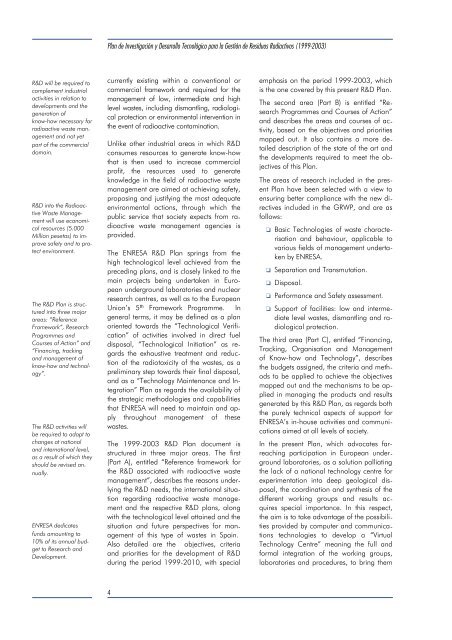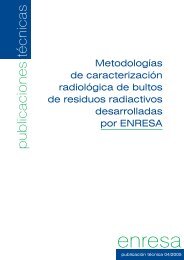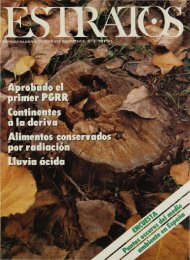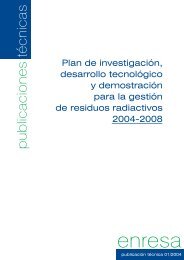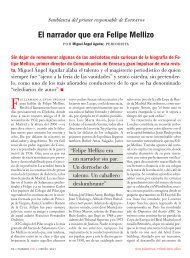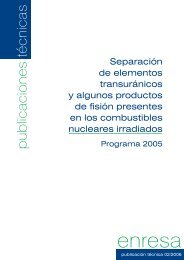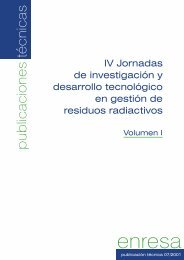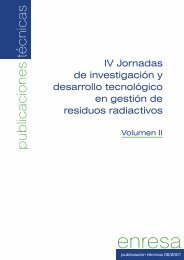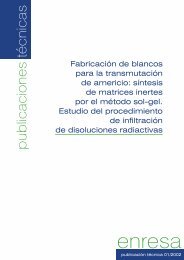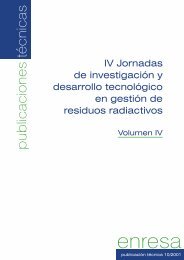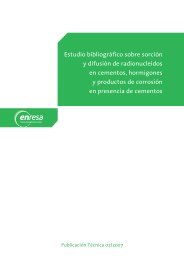Descargar PDF (4473 KB) - Enresa
Descargar PDF (4473 KB) - Enresa
Descargar PDF (4473 KB) - Enresa
You also want an ePaper? Increase the reach of your titles
YUMPU automatically turns print PDFs into web optimized ePapers that Google loves.
R&D will be required to<br />
complement industrial<br />
activities in relation to<br />
developments and the<br />
generation of<br />
know-how necessary for<br />
radioactive waste management<br />
and not yet<br />
part of the commercial<br />
domain.<br />
R&D into the Radioactive<br />
Waste Management<br />
will use economical<br />
resources (5.000<br />
Million pesetas) to improve<br />
safety and to protect<br />
environment.<br />
The R&D Plan is structured<br />
into three major<br />
areas: “Reference<br />
Framework”, Research<br />
Programmes and<br />
Courses of Action” and<br />
“Financing, tracking<br />
and management of<br />
know-how and technology”.<br />
The R&D activities will<br />
be required to adapt to<br />
changes at national<br />
and international level,<br />
as a result of which they<br />
should be revised annually.<br />
ENRESA dedicates<br />
funds amounting to<br />
10% of its annual budget<br />
to Research and<br />
Development.<br />
Plan de Investigación y Desarrollo Tecnológico para la Gestión de Residuos Radiactivos (1999-2003)<br />
currently existing within a conventional or<br />
commercial framework and required for the<br />
management of low, intermediate and high<br />
level wastes, including dismantling, radiological<br />
protection or environmental intervention in<br />
the event of radioactive contamination.<br />
Unlike other industrial areas in which R&D<br />
consumes resources to generate know-how<br />
that is then used to increase commercial<br />
profit, the resources used to generate<br />
knowledge in the field of radioactive waste<br />
management are aimed at achieving safety,<br />
proposing and justifying the most adequate<br />
environmental actions, through which the<br />
public service that society expects from radioactive<br />
waste management agencies is<br />
provided.<br />
The ENRESA R&D Plan springs from the<br />
high technological level achieved from the<br />
preceding plans, and is closely linked to the<br />
main projects being undertaken in European<br />
underground laboratories and nuclear<br />
research centres, as well as to the European<br />
Union’s 5 th Framework Programme. In<br />
general terms, it may be defined as a plan<br />
oriented towards the “Technological Verification”<br />
of activities involved in direct fuel<br />
disposal, “Technological Initiation” as regards<br />
the exhaustive treatment and reduction<br />
of the radiotoxicity of the wastes, as a<br />
preliminary step towards their final disposal,<br />
and as a “Technology Maintenance and Integration”<br />
Plan as regards the availability of<br />
the strategic methodologies and capabilities<br />
that ENRESA will need to maintain and apply<br />
throughout management of these<br />
wastes.<br />
The 1999-2003 R&D Plan document is<br />
structured in three major areas. The first<br />
(Part A), entitled “Reference framework for<br />
the R&D associated with radioactive waste<br />
management”, describes the reasons underlying<br />
the R&D needs, the international situation<br />
regarding radioactive waste management<br />
and the respective R&D plans, along<br />
with the technological level attained and the<br />
situation and future perspectives for management<br />
of this type of wastes in Spain.<br />
Also detailed are the objectives, criteria<br />
and priorities for the development of R&D<br />
during the period 1999-2010, with special<br />
4<br />
emphasis on the period 1999-2003, which<br />
is the one covered by this present R&D Plan.<br />
The second area (Part B) is entitled “Research<br />
Programmes and Courses of Action”<br />
and describes the areas and courses of activity,<br />
based on the objectives and priorities<br />
mapped out. It also contains a more detailed<br />
description of the state of the art and<br />
the developments required to meet the objectives<br />
of this Plan.<br />
The areas of research included in the present<br />
Plan have been selected with a view to<br />
ensuring better compliance with the new directives<br />
included in the GRWP, and are as<br />
follows:<br />
Basic Technologies of waste characterisation<br />
and behaviour, applicable to<br />
various fields of management undertaken<br />
by ENRESA.<br />
Separation and Transmutation.<br />
Disposal.<br />
Performance and Safety assessment.<br />
Support of facilities: low and intermediate<br />
level wastes, dismantling and radiological<br />
protection.<br />
The third area (Part C), entitled “Financing,<br />
Tracking, Organisation and Management<br />
of Know-how and Technology”, describes<br />
the budgets assigned, the criteria and methods<br />
to be applied to achieve the objectives<br />
mapped out and the mechanisms to be applied<br />
in managing the products and results<br />
generated by this R&D Plan, as regards both<br />
the purely technical aspects of support for<br />
ENRESA’s in-house activities and communications<br />
aimed at all levels of society.<br />
In the present Plan, which advocates farreaching<br />
participation in European underground<br />
laboratories, as a solution palliating<br />
the lack of a national technology centre for<br />
experimentation into deep geological disposal,<br />
the coordination and synthesis of the<br />
different working groups and results acquires<br />
special importance. In this respect,<br />
the aim is to take advantage of the possibilities<br />
provided by computer and communications<br />
technologies to develop a “Virtual<br />
Technology Centre” meaning the full and<br />
formal integration of the working groups,<br />
laboratories and procedures, to bring them


